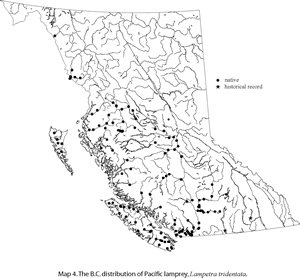Characterized by the presence of 3 (rarely 2) large sharp teeth on the supraoral bar and three sharp points on each of the central lateral tooth plates (Ref. 27547). Dorsal fins arise far back on the body, the anterior fin lower and shorter, higher in males; lower lobe of caudal fin larger than upper, the lobes joined to dorsal and anal fins; anal fin rudimentary, virtually absent in males (Ref. 27547). Adults from the sea blue-black to greenish above, silvery to white below; spawning adults become reddish brown (Ref. 27547).
Source: FishBase. Page, L.M. and B.M. Burr 1991 A field guide to freshwater fishes of North America north of Mexico. Houghton Mifflin Company, Boston. 432 p.
